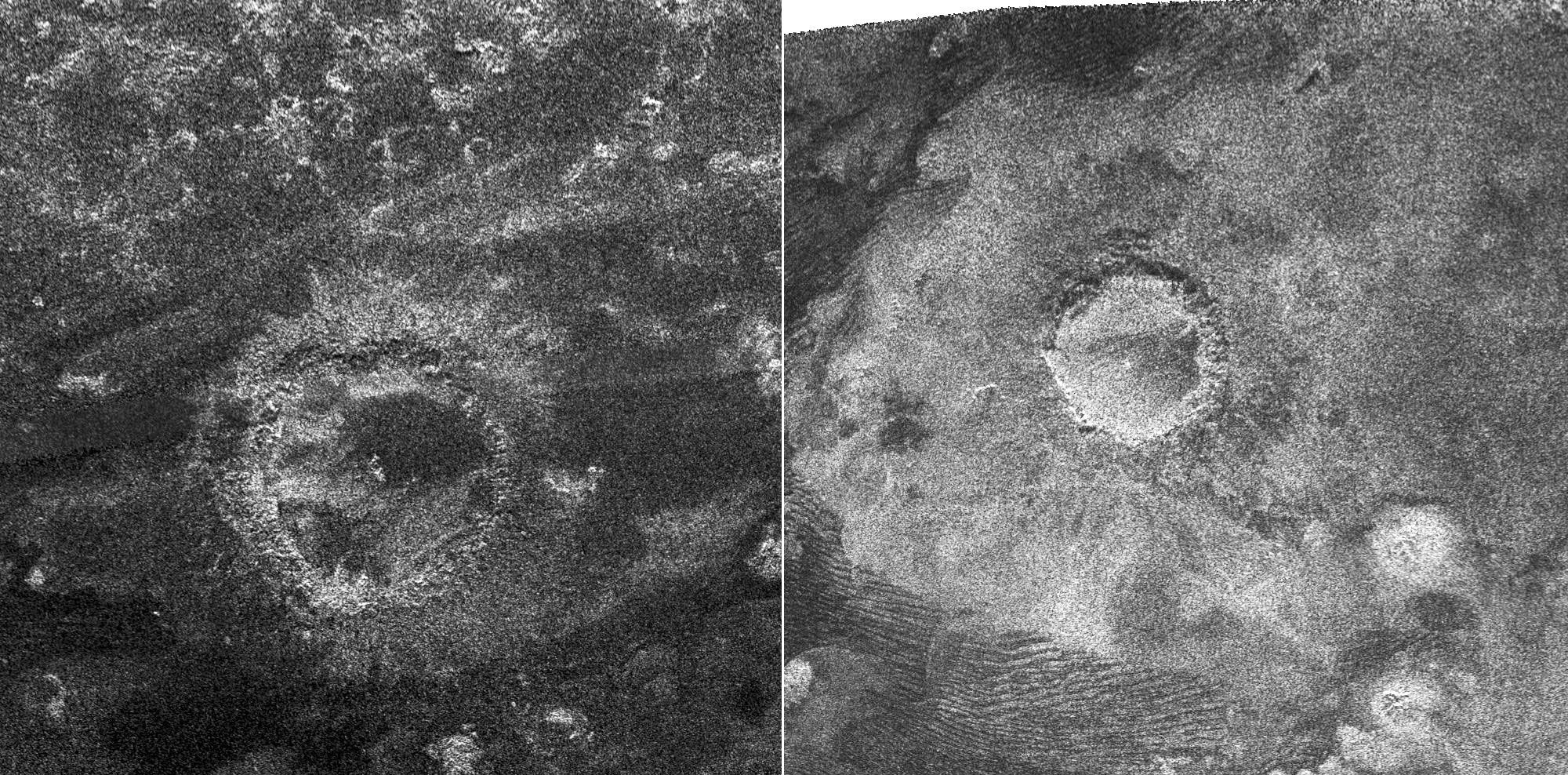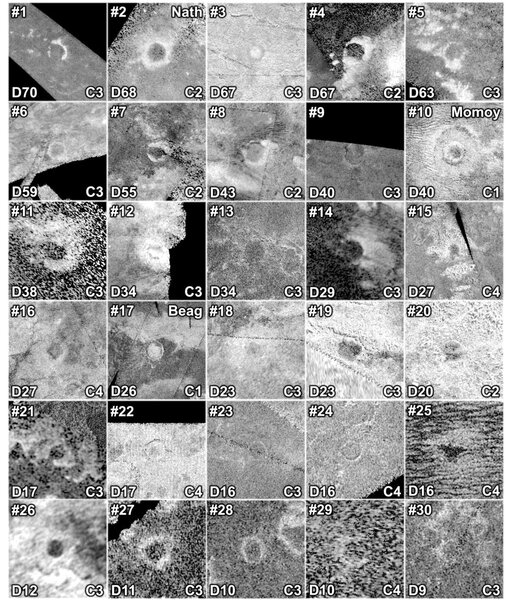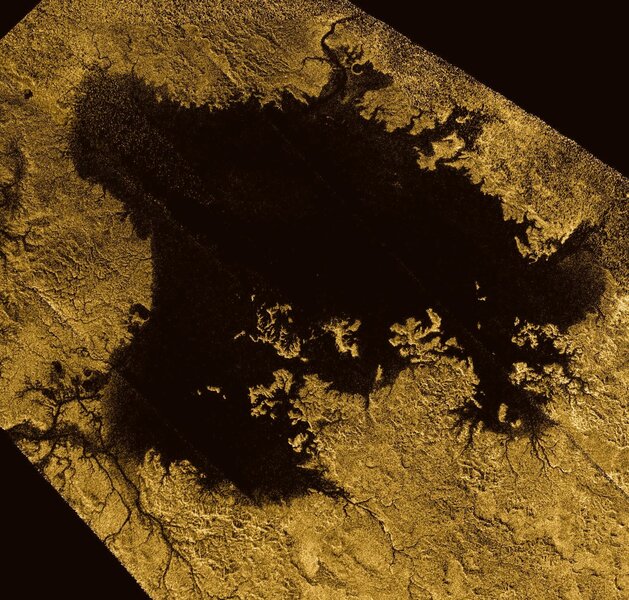Create a free profile to get unlimited access to exclusive videos, sweepstakes, and more!
Are rivers of liquid methane washing away craters on Saturn’s moon Titan?

Titan is Saturn's largest moon, and the second biggest in the solar system. It's a world unto itself; nearly as big as Mercury, with a nitrogen atmosphere with higher surface pressure than Earth. The Cassini spacecraft swept past the giant moon an incredible 127 times over its 13-year tour of the Saturn system, taking close-up images of the moon.
The thick atmosphere blocks visible light, but by using radar Cassini could not only "see" Titan's surface, it could map height of features there. It can also detect how rough the terrain is; smooth areas don't reflect radar well, so look dark, while bumpy surfaces look bright as they reflect a lot of the radar waves back to Cassini.
You might think there would be plenty of craters there, but until recently only 60 were seen. Small craters are difficult to spot, of course, and there may be fewer anyway due to Titan's thick air; smaller comets and asteroids explode before they reach the ground (like the Chelyabinsk asteroid did in 2013 over Russia). But even then, craters are rare. That implies erosion, like on Earth; on airless bodies like the Moon craters are saturated, shoulder-to-shoulder, but on our active Earth very few are seen.
But what's doing the eroding? We know that wind plays a role on the surface. The equator of Titan is lined with dunes, made up of grains that are not sand but instead frozen nuggets of hydrocarbons. But studies have shown that winds on Titan are too slow to do much by the way of erosion.
So what's been repaving Titan's craters? A new paper looking at Cassini radar measurements draws a very interesting conclusion: It's not air, but liquid. And not water (which is frozen into solid rock by the frigid temperatures so far from the Sun), but liquid methane.
They came to this idea looking at the structures of the craters. When an incoming asteroid hits the surface, it carves out a huge bowl. Material is flung away from the newly formed crater, piling up around it. Also, the bowl will have a raised rim around it from material pushed upwards by the impact.
First, the scientists looked for craters in the data with these features. 60 had been found before, but in the new study they discovered 30 more candidates. They looked for circular features with dark floors and bright material around them; the assumption is that blocky ejected material around the crater will be radar reflective, while the floors would be smooth and dark as, over time, sand or other stuff fills in the crater. Not every crater fit those criteria, but many did.
Then for the ones they could they looked at the rim height above the surface and the floor depth below it. Pristine craters tend to have high, sharp rims, and older ones are more degraded.
Once they had those results, they compared them to craters on Jupiter's moons Ganymede and Callisto, which are roughly the same size, mass, and surface gravity as Titan (noting that impact speeds are lower farther from the Sun, where orbital speeds are slower, so pound for pound Titan impacts tend to happen with less energy). What they found is that Titan's craters were much shallower than the other two moons.
This, they conclude, is due to infill, material flowing into the Titan craters. But was that driven by wind or fluid?
Well, they found that the rims of Titan craters were degraded, too. It has already been established that air-driven processes are weak on Titan, so from all this they conclude that liquid is flowing over and into the craters, eroding the rims and leaving behind sediments on the floor.
So where does the liquid come from? The poles of Titan are covered in lakes of liquid methane (also discovered and confirmed by Cassini observations). There's obvious evidence of rivers and tributaries leading from higher elevations down into those lakes, strongly suggesting Titan has something like Earth's water cycle but with methane instead: Methane evaporates from the lakes, precipitates down in the higher hills as rain or snow, which then melts, flows along those rivers, and refills the lakes.
So it's possible the craters on Titan are getting flooded, which is why they are so degraded. The authors don't speculate too specifically on how this works, just saying that it's likely fluvial (liquid flowing) processes doing the work. I would guess that seasonal weather might bring rains that could then flood the craters.
Oh, how cool would it be to have a dedicated Titan orbiter and surface explorer? Something that could be there for a couple of decades to see how the seasons change what's going on there?
And hey, NASA is planning a future lander: Dragonfly, a quadcopter which can hop around the surface of Titan, examining different places in detail. That mission has a 32-month baseline, but missions like this tend to get extended if they perform well. It may not be long enough to see seasonal changes, but wow, what a chance to see this weird, alien world up close.
… and yet, despite being so different from Earth, it's so familiar. Thick air, liquid, rain, lakes, seasons… it may be frigid compared to what we're used to, but frozen it isn't.

















